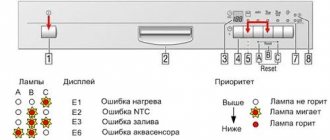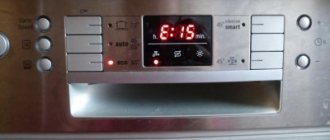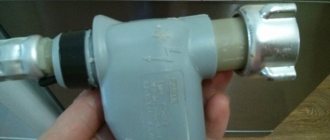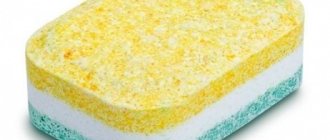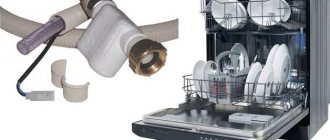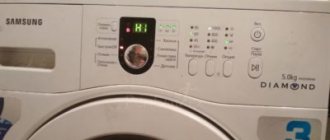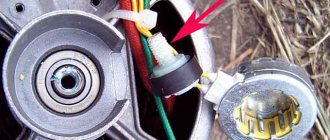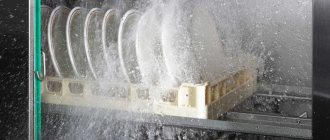Calculate cost Reviews Geography Contacts
BOSCH service center No. 1 in Moscow Post-warranty service and repair of BOSCH with home visits seven days a week from 9:00 to 22:00
8 Call back
A malfunction in which the BOSCH dishwasher does not turn off manifests itself in different ways. In some cases, after pressing the button, the machine does not allow you to select a mode and does not start the wash, while leaving the door locked and the backlight working. In others, the machine actively washes the dishes, water is poured in and drained, but the process continues endlessly.
Before looking for a breakdown, make sure that the buttons are not stuck and the mode has not been changed. In some cases, the machine takes longer to wash dishes than usual, which bothers its owner. If the mode is normal, but the BOSCH dishwasher does not turn off, and you can only stop it by unplugging the cord from the outlet, the problem may be:
- in a faulty pump;
- in control unit errors.
As a result, in the first case, the pump continues to work - pumping water through the machine, in the second - a system failure occurs, due to which the equipment “freezes”, stops washing, or repeats the same cycle endlessly.
What to do if the dishwasher won't turn off?
Make sure that the machine is really frozen or faulty. You may have changed the mode yourself, so it works a little longer than usual. If the mode has not changed, and the machine does not complete the wash or does not even start it, the first thing to do is:
- disconnect the equipment from the network;
- remove the dishes (as a rule, after switching off, the locking device stops holding the door);
- drain off any water if any remains.
In the future, you need to call a technician who will check the main components. If you have electrical experience, you can try to check the control unit yourself.
Most often the problem is caused by a faulty or malfunctioning pump. Its operation may be affected by a hose that is too long or blocked, the slope of the BOSCH dishwasher and other factors. The pump itself may also break.
Power problems
Symptoms: the car is “dead”: the indicators do not light up, no sounds are heard
The most common reason - a power outage - can occur at any time. But the voltage may also disappear due to problems in the PMM itself: if other devices connected to the same outlet work normally, then you need to call a technician. The washing program may also stop due to a power surge: for self-protection purposes, the control module will stop operating the dishwasher. If voltage surges are a common occurrence in your apartment, purchase a stabilizer.
What repairs will be needed if the dishwasher won't turn off?
There are only two options.
The first is replacing or repairing the pump. If the pump constantly pumps water and the machine cannot stop, replacement is the only solution (provided that the control unit is working without errors).
The second is repair, replacement or flashing of the control unit. The electronic board can be resoldered or replaced. Reflashing is done in the entire block if the program freezes or gives an error. Most often, with such a malfunction, the BOSCH dishwasher simply does not start working, does not allow you to select a mode, and does not respond to button presses.
The temperature sensor or heating element is faulty
Symptoms: the noise of water being drawn is heard, but after a while the washing process stops
For efficient washing, the water must be heated to the temperature specified in the program: if this does not happen, the washing will stop. The cause may be either a burnt heating element (heating element) or a faulty temperature sensor (thermostat). And if the heating element can still be relatively easily replaced by yourself, then it is better to entrust it to an experienced technician to diagnose the malfunction of the sensor and replace it with the “correct” one.
Low prices
| Service | Price |
| Diagnostics | |
| When ordering repairs | For free |
| In case of refusal of repair | 1 standard hour |
| Full product diagnostics (functionality check) | 2 standard hours |
| Major renovation | |
| Replacing the recirculation pump | 2.5 standard hours |
| Replacing the electric motor | 1.5 standard hours |
| Replacing the electrical harness | 2.2 standard hours |
| Replacement of housing elements | 2 standard hours |
| Repair of medium complexity | |
| Sealing or replacing pipes | 1 standard hour |
| Replacing the drain pump | 1.2 standard hours |
| Removing clogged drain pumps and hard-to-reach pipes | 1.2 standard hours |
| Replacing the solenoid valve | 1.5 standard hours |
| Replacing the heating element | 1.5 standard hours |
| Replacing the drying fan | 1.9 standard hours |
| Replacing the level sensor | 1.1 standard hours |
| Replacing the display unit, electronic module | 1.7 standard hour |
| Electrical circuit repair | 2 standard hours |
| Configuration (firmware) of the electronic unit | 2 standard hours |
| Replacement of signal lamps of the dispenser, front panel | 1 standard hour |
| Belt replacement | 1.1 standard hours |
| Cleaning the dryer | 1.5 standard hours |
| Replacing the drying heating element | 1.5 standard hours |
| Replacement of thermostat, drying timer, door lock | 1.5 standard hours |
| Removing Foreign Objects | 1.6 standard hour |
| Minor repairs | |
| Replacing the hook, hatch handle, hatch fastening, glass | 0.8 standard hours |
| Replacing the door seal | 1.6 standard hours |
| Opening the door | 1 standard hour |
| Replacement of the power button, capacitor, surge protector, power cord, repair of the KSMA indicator | 0.7 standard hours |
| Replacing the drain hose | 1.2 standard hours |
| Replacing the aquastop (hydrostop) | 1.2 standard hours |
| Minor repairs (without disassembling the machine) | 0.5 standard hours |
| Maintenance | 1 standard hour |
| Related | |
| Repair of units, modules | 50% of the price of new |
| Installation and dismantling of the built-in device | 1 standard hour |
| Cleaning the system | 1 standard hour |
| Markup coefficient | |
| Embedding | 1,8 |
| Premium model | 1,8 |
| Urgent departure (within 15 minutes) | 1,5 |
| Cramped working conditions | 1,5 |
| Any repairs involving complete disassembly of the product | 2,5 |
| Basic values | |
| Standard hour (rounded up to half an hour) | 1000 |
| Final provisions | |
| ● When repairing the control board, the technician takes the board, after the repair he returns it and installs it ● Spare parts and consumables are paid separately ● Travel outside the city - 40 rubles/km ● The final price of the repair is determined by the technician, based on the complexity of the breakdown and the volume of work performed | |
Problems with the control module
Symptoms: any, but, as a rule, the washer does not start at all, there is not even any water supply
The worst and most expensive thing that can happen to a PMM is a breakdown of the control module: it cannot be repaired - only replaced: it itself is not cheap, and even replacement and diagnostic work costs a lot of money.
group: message participants: 5,044 resides: Russia, Russia, Moscow
group: members+ messages: 32,013 resides: Russia, Moscow
| The dishwasher stopped working properly. How to continue living Stops in the middle of the program, immediately after washing with hot water. There should be a rinsing cycle next, but it is not done. It looks like the aquastop is working. After the first shutdown, it didn’t work—it didn’t take water. But today it started working and if I turned on the pre-rinse program, I completed it completely. But when I tried to run the full wash program, I again stopped in the middle and again did not take water. It seems that for some reason the AquaStop system is triggered after hot water. I called several technicians, but they all refused to look, citing the antiquity of the machine. But I don’t want a new one - I don’t like the very long washing cycle. Mine does a full wash in 65-70 minutes, while the new ones take two and a half hours. |
group: message participants: 5,044 resides: Russia, Russia, Moscow
| 30 minutes is a lighter option for washing. With lower water temperatures and fewer water changes. I'm familiar with new models, since there is one in the village. However, that's not what the topic is about. |
group: members+ messages: 14,953 resides: Russia, overlooking Moscow
group: message participants: 5,044 resides: Russia, Russia, Moscow
group: members+ messages: 14,953 resides: Russia, overlooking Moscow
group: members+ messages: 15,132 resides: Russia, still here
| In general, cleaning equipment helps in most cases. Secondly, why did you decide that it was an avostop? And if it’s him, maybe there’s a reason after all, i.e. - a leak? Third, if after it’s hot, then, as an option, steam gets into the electronics and the protection is triggered. ps I’m never a master, purely logical calculations |
group: message participants: 5,044 resides: Russia, Russia, Moscow
I would be glad for any advice, since I don’t feel like buying a new one.
| I took apart the dishwasher. Water flows from a hose that leads from I don’t know where, but into the pan. And there it plays the role of a fuse, that is, water flows from it directly into the pan, and there is a float there, which turns off the machine. Water from this hose begins to flow at the moment when the dishwasher pours water into the tank from the side container. I inserted the hose into the bottle, the water drained there, and the machine worked the entire cycle. According to the master, it is the filler valve that is leaking, which is not and will not be available for this model. I found a disassembly of a similar valve on one of the forums, but I don’t know whether mine will be the same. Here's the hose where it's leaking from |
Read also: Hair dryer for welding polypropylene sheets
group: participants+ messages: 20,928 country: Russia
Try to understand more precisely where the current hose is coming from. There, all the hoses in the pan must be emergency, i.e. overflow, drain when level is exceeded. Localize the breakdown.
220V, or =24V, or =12V. Either way, these valves are like dirt. For any voltage, different designs. If one doesn’t fit, you install another, the thread is not the same, you make an adapter. If the solenoid does not work, then simply put a new one on the old valve.
In short, localize the problem more accurately. The valve is not the problem.
group: participants+ messages: 20,928 country: Russia
A leak may be due to the primitive reason of an incorrect or large amount of powder. When there is a lot of foam inside.
| Yes, still. |
group: message participants: 5,044 resides: Russia, Russia, Moscow
There is only one emergency there. There are two more, but one of them leads somewhere, and the second is muffled. As I understand it, it is for draining water from the block before dismantling. The hose comes from somewhere below from this block
Here's how in this thread https://www.elremont.ru/forum/viewtopic.php?t=13470 I have nowhere to grind the rod
group: participants+ messages: 20,928 country: Russia
Purely logical. Here's a plastic block. Some are dirty, some are clean. The bay is a dirty area, a clean area is circulation during washing. This block itself is a kind of replacement for a bunch of valves and tubes. Everything in it is based on Archimedes' law. Water flowing out during filling is overflow drainage. What does this mean? This means that the water being poured either has a very strong inlet flow or a very weak outlet. Strong pressure at the inlet is unlikely, leaving a weak outlet. And the weak solution is dirt. This means you need to carefully look at where the flow goes when drawing water and clean this channel. Maybe the drainage is up to the filter, then a clogged filter will cause an overflow.
That's right, logic. Maybe not literally, but somewhere like that.
With water it’s simple, everything is visible. I've been struggling with air conditioning for a week. I just figured it out today. One transistor was slightly burnt. I even desoldered it and checked it - it works. But in the block this circuit (water valve) does not work. I was already thinking that maybe one of the controller outputs had burned out, even though everything else was working. In short, I gave up on the Soviet transistor today, after a bunch of experiments, everything worked.
group: banned messages: 31,231 resides: Varna - Moscow
| I didn’t read into the posts about disassembling the machine, but when our washing machine started behaving like this, it turned out that the heating element had burned out due to scale. A short circuit occurred and the program went astray. Moreover, the master immediately determined the reason over the phone. They called from A-Iseberg. He arrived very quickly and replaced everything. |
Subscribe to topic
Notification by e-mail about replies to a topic during your absence from the forum.
Subscribe to this forum
Notification by e-mail about new topics on the forum during your absence from the forum.
Download/Print theme
Download the theme in various formats or view a printable version of the theme.
% discounts
| Types of jobs | Discount for master's work |
| Replacing one part | 10% |
| Replacing two parts | 20% |
| Replacing three parts | 30% |
| To whom | |
| WWII veterans | 50% |
| Low-income citizens | 20% |
| Large families | 20% |
| Single mothers | 20% |
| Pensioners | 20% |
| Disabled people of the 1st group | 20% |
| For students | 10% |
Checking the “Aquastop” function
If a Bosch brand dishwasher is equipped with a system to protect equipment from leaks, then there is a possibility that the appearance of the described icon on the panel is the result of its operation. When the Aquastop function is activated, the water supply automatically stops. It is worth noting that the appearance of an error code is not necessary, while the indicator flashes.
- turn off the dishwasher by unplugging the power cord from the outlet;
- tilt the machine several times in different directions - such manipulations can help the float take its normal (working) position;
- completely drain the water in the pan;
- wait until completely dry.
When mechanical protection is activated, it will have to be replaced with a new one.
You can find out more information on this issue in the video below.
Typical dishwasher malfunctions and their repair - repair recommendations
With machines whose warranty period has expired, everything is simpler - you can disassemble them, try to replace small parts yourself, and if you have enough experience, then carry out complex repairs.
Let's look at the most common problems faced by dishwasher owners and find out how to get these irreplaceable assistants to work.
Problem #1 - poor cleaning quality
If your dishwasher does not wash dishes well and does not completely wash the dishes, we are looking for the reasons for the “wrong behavior”.
Whitish stains on plates, food residues smeared on the bottom of a pan, glasses that have lost their transparency - all these are signs of poor-quality washing. They appear when the rules for operating the machine are violated or the wrong choice of detergents is used.
Poor cleaning is also often caused by untimely cleaning of filters. It’s easier to start checking by inspecting the internal surfaces and parts.
It is necessary to unscrew the filters, remove the spray arms, thoroughly clean everything with brushes under running water and put it back in place.
The filter mesh on the water supply hose also needs to be washed regularly. If it becomes clogged with dirt particles, the water pressure weakens, and the dishes are poorly rinsed. Incorrectly selected detergents or improper dosage also affect the quality of washing.
The lack of rinse aid results in powder stains remaining on glass and ceramic dishes. The same result is achieved by using products not intended for use in PMM.
Carefully read the instructions for the machine, especially the section on detergents, and also read the recommendations for powders and rinses.
Be sure to follow the stacking order recommended by the manufacturer - place cups in the top tray, plates in the middle, and large utensils in the bottom. If you violate the scheme, then heavily soiled dishes will not receive sufficient care.
Problem #2 - water remains inside the case
A small puddle at the bottom of the washing chamber is a sign of normal functioning of the machine.
A certain amount of liquid is necessary to maintain a certain level of humidity - with it, rubber seals do not dry out and remain elastic longer. But excess water is a signal of a malfunction of the PMM.
There are several main reasons for water stagnation in the pan:
- the outlet hose is connected too high, which is why the water is in no hurry to leave the washing chamber; it is necessary to lower the outlet to a height of 35–45 cm;
- clogged due to improper care - filters should be cleaned approximately once every 1-2 weeks;
- pump - malfunction of the pumping device;
- sensor – failure of the water level sensor.
If the first two reasons can be eliminated on your own, then difficulties may arise with the second. Broken sensors or pump require replacement.
The best way out is to invite a specialist from the service center for detailed diagnostics and selection of suitable spare parts.
Both types of parts (pump and sensor) can be original or alternative. The original ones usually cost more, while the Chinese counterparts are cheaper.
However, when trying to save money, do not go wrong with the quality of spare parts - it is better to read reviews in advance and consult with a service employee.
Problem #3 - unexpected machine shutdown
A dishwasher that stops working before the end of the cycle is an alarming signal. An isolated case can be explained by an electronic system failure or a power surge, but regular shutdowns most likely indicate problems with the power supply.
To begin with, you can apply a restart - press the “on” button. after 20–30 seconds. If the washing process has started, the current in the network has stabilized.
If the network is weak and overloads occur from time to time, it is better to invest in a stabilizer - this way you will prevent possible failures and thereby save machine parts. The cause of a temporary lack of voltage in the network may be electrical installations - sockets, tees or filters.
“Middlemen” between the outlet and the power cord should be avoided; it is better to use a direct connection. But if you still use a surge protector, then choose a device with a fuse.
If you have previously replaced the heating element in a boiler or washing machine, you can also repair the dishwasher. It is important to correctly select a part similar to the broken one and carefully install it.
The most difficult thing is when the dishwasher is constantly stopped by the control module with malfunctions in the program. It is almost impossible to repair it on your own, so it is better to invite a specialist to diagnose and repair it.
Problem #4 - unregulated water drainage
Such a malfunction may not be noticed immediately. The motor and pump of the machine are constantly in operation, water enters and immediately leaves the washing chamber, while the dishes still remain dirty.
If you look at the cold water meter, the problem can be identified faster - it collects liters that are wasted down the drain.
However, sometimes the electronic control system does not work, and you have to guess based on indirect signs - water drainage, pump operation.
If the water inlet valve is faulty, the process of filling and draining becomes endless. Water flows in, but there is no signal to stop. An overflow is created, which is eliminated by automatically turning on the pump.
In such cases, you can do one of the following:
- Turn off the water.
- Turn off the power supply.
- Reach the connection point for the inlet hose.
- Disconnect the hose and remove the filter.
- Locate the valve and check its functionality.
Use a multimeter to check. The probes are attached to the intake valve contacts and determine the resistance. The norm is 500-1500 Ohms, other values indicate a malfunction. The broken part must be replaced.
Another reason is electronic failure. The repair can be done by anyone who can resolder the pump triac or perform similar actions. Otherwise, it is better to contact the service center.
Problem #5 - dishes are not drying
Remaining drops of water on dishes can turn into unsightly spots and stains, so the dishes must be dried thoroughly. If the dishwasher regularly does not dry the dishes, we determine the reasons on our own.
The most common type of drying in budget and mid-range dishwashers is condensation.
That is, the dishes dry naturally, and only the body heated after washing helps them do this. Once the metal cools, the drying process will slow down. To extend it, the car door is opened slightly.
The first reason is a breakdown of the heating element or temperature sensor. Repairs will not bring much success, so it is better to replace these parts immediately. When replaced at a service center, they sometimes give a 6-month warranty on the newly installed part.
The second reason is the fan. It applies to machines equipped with turbo drying. If the fan fails, the forced supply of hot air stops and the dishes remain damp.
The solution is to replace the fan. It can be located both in the upper and lower parts of the washing chamber, and on some models - on the side.
When choosing a new one, you should consider the make and model of the car. A “non-original” part will not fully cope with its task, so try to choose an analogue of the broken device that is suitable in terms of technical characteristics.
Problem #6 - The car makes a loud noise
This is one of the most common complaints received from consumers when a dishwasher is sent in for repair. A loud noise, not typical for a working machine, indicates the failure of one of the parts.
There are two main reasons: the bearing of the circulation pump that supplies water has worn out, or the pump has failed.
To replace the bearing, you must remove the pump by following these steps:
- turn off the power supply;
- dismantle the pallet;
- unscrew the pump, loosening the clamps;
- Carefully disconnect the wires and pipes.
Having removed the pump, we disassemble it to get to the bearing. First, remove the heating element, then remove the impeller and armature.
In the depths, under the other parts, there is a bearing. Under it there is a gasket, which is also a consumable. If it is worn out, it is better to replace it immediately, otherwise you will have to disassemble the pump again later.
We take out the “knocking” bearing and insert a new one in its place. We perform assembly in reverse order.
Installing a new pump follows the same procedure: we dismantle the old device, find the breakdown and, if it is serious and cannot be repaired, replace it. For ease of work, the machine can be placed on its side if conditions permit.
Problem #7 - foam does not wash off after washing
The dish cleaning process is designed in such a way that first the detergent enters the chamber, then the rinse aid, and at the end all remaining substances are washed off with water.
If at the end of the cycle there are foam residues left on the bottom of the chamber, on the walls or baskets, this indicates either improper use of detergents or a failure in the settings.
To avoid violent foaming, you need to study the instructions, remember the dosage and follow the manufacturer's recommendations.
A number of models are not designed for the use of 3-in-1 tablets. As a result, the machine does not correctly recognize the product, and by the end of the cycle it does not have time to completely dissolve.
If the function of using universal tablets is present, but separate products were previously installed, you need to change the dishwasher settings. How this happens is described in detail in the instructions.
A clogged filter can also be the cause of excessive foam at the bottom of the box. Residues of food serve as an obstacle to the drainage of water, especially foamy water, as a result of which some of it remains at the bottom by the end of the cycle. The situation will be improved by simply cleaning the filter.
Source: https://sovet-ingenera.com/tech/posudomoyki/remont-posudomoechnoj-mashiny-svoimi-rukami.html
